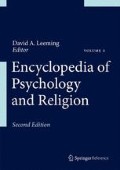Bibliography
Adso. (1976). De ortu et tempore Antichristi: necnon et tractatus qui ab eo dependunt. Turnholt: Brepols.
Alighieri, D. (1948). The divine comedy: Inferno, purgatorio, paradiso. New York: Pantheon Books.
Bettelheim, B. (1976). The uses of enchantment: The meaning and importance of fairy tales. New York: Alfred Knopf.
Collins, A. Y. (1979). The apocalypse. New Testament message (O. P. W. Harrington & C. P. D. Senior, Eds.) (Vol. 22). Wilmington: Michael Glazier.
Dostoevsky, F. (1990). The brothers Karamazov (trans: Pevear, R. & Volokhonsky, L.). San Francisco: North Point Press.
Emmerson, R. K. (1981). Antichrist in the Middle Ages: A study of medieval apocalypticism, art, and literature. Seattle: University of Washington Press.
Flanagan, S. (2000). Twelfth-century apocalyptic imaginations and the coming of the Antichrist. Journal of Religious History, 24(1), 57–69.
Fuller, R. C. (1995). Naming the Antichrist: The history of an American obsession. New York: Oxford University Press.
Harris, G. H. (1999). The wound of the beast in the tribulation. Bibliotheca Sacra, 156(624), 459–468.
Hazelip, H. (1975). Revelation 20 and the millennium. Restoration Quarterly, 18(4), 229–235.
Hughes, K. L. (2005). Constructing Antichrist: Paul, biblical commentary, and the development of doctrine in the early Middle Ages. Washington, DC: Catholic University of America Press.
Jackson, P. (Director). (2001). The Lord of the Rings: The fellowship of the ring. New Line Cinema.
Jackson, P. (Director). (2002). The Lord of the Rings: The two towers. New Line Cinema.
Jackson, P. (Director). (2003). The Lord of the Rings: The return of the king. New Line Cinema.
Jung, C. G. (1959). Aion: Researches into the phenomenology of the self (trans: Hull, R. F. C.). In H. Read, M. Fordham, G. Adler & W. McGuire (Eds.), The collected works of C.G. Jung (Bollingen Series XX, Vol. 9, Pt. II). Princeton: Princeton University Press.
Kidd, T. S. (2003). Is it worse to follow Mahomet than the devil? Early American uses of Islam. Church History, 72(4), 766–788.
King, S. (1991). The stand. New York: Random House.
Krey, P. D. W. (2007). Nicholas of Lyra's commentary on Daniel in the Literal Postill (1329). Geschichte der Daniel-Auslegung in Judentum, Christentum und Islam (pp. 199–215). Berlin: Walter de Gruyter.
Krey, P. D. W., & Smith, L. (Eds.). (2000). Nicholas of Lyra: The senses of scripture. Leiden: Brill.
Lake, P., & Questier, M. (2002). The Antichrist’s lewd hat: Protestants, papists and players in post-reformation England. New Haven: Yale University Press.
Larondelle, H. K. (1989). The Middle Ages within the scope of apocalyptic prophecy. Journal of the Evangelical Theological Society, 32(3), 345–354.
Leppin, V. (1999). Antichrist und Jüngster Tag: Das Profil apokalyptischer Flugschriftenpublizistik im deutschen Luthertum 1548–1618. Quellen und Forschungen zur Reformationsgeschichte, Band 69. Heidelberg: Gütersloher Verlagshaus.
Lerner, R. E. (1981). The black death and western European eschatological mentalities. The American Historical Review, 86(3), 533–552.
Levin, I. (1967). Rosemary’s baby. New York: Random House.
Lieu, J. (1981). Authority to become children of God: A study of 1 John. Novum Testamentum, 23(3), 210–228.
Lindsey, H., & Carlson, C. C. (1973). The late, great planet earth. Grand Rapids: Zondervan.
Lorein, G. W. (2003). The Antichrist theme in the intertestamental period. New York: T & T Clark International.
MacLeod, D. J. (1999). The second ‘last thing’: The defeat of Antichrist (Rev 19:17–21). Bibliotheca Sacra, 156(623), 325–335.
McGinn, B. (1978). Angel pope and papal Antichrist. Church History, 47(2), 155–173.
McGinn, B. (2000). Antichrist: Two thousand years of the human fascination with evil. New York: Columbia University Press.
Misner, P. (1973). Newman and the tradition concerning the papal Antichrist. Church History, 42(3), 377–395.
Nichols, S. J. (2001). Prophecy makes strange bedfellows: On the history of identifying the Antichrist. Journal of the Evangelical Theological Society, 44(1), 75–85.
O’Leary, S. D. (1994). Arguing the apocalypse: A theory of millennial rhetoric. New York: Oxford University Press.
Patai, R. (1979). The Messiah texts. New York: Avon Books.
Patterson, J. A. (1988). Changing images of the beast: Apocalyptic conspiracy theories in American history. Journal of the Evangelical Theological Society, 31(4), 443–452.
Polanski, R. (Director). (1968). Rosemary’s baby. William Castle Productions.
Ratner-Rosenhagen, J. (2006). Conventional iconoclasm: The cultural work of the Nietzsche image in twentieth-century America. The Journal of American History, 93(3), 728–754.
Reeves, M. (1969). The influence of prophecy in the later Middle Ages: A study in Joachinism. Oxford: Clarendon.
Ricoeur, P. (1967). The symbolism of evil (R. N. Anshen, Ed., trans: Buchanan, E.). New York: Harper & Row. (Reprinted from Religious Perspectives (Vol. 17)).
Shuck, G. W. (2004). Marks of the beast: The left behind novels, identity, and the internalization of evil. Nova Religio, 8(2), 48–63.
Steinmann, A. E. (2005). Is the Antichrist in Daniel 11? Bibliotheca Sacra, 162(646), 195–209.
Strohm, S. (2007). Luthers Vorrede zum Propheten Daniel in seiner Deutschen Bibel. Geschichte der Daniel-Auslegung in Judentum, Christentum und Islam (pp. 219–243). Berlin: Walter de Gruyter.
Tolkien, J. R. R. (1965). The Lord of the Rings. New York: Ballantine Books.
Wong, D. K. K. (1996). The first horseman of revelation 6. Bibliotheca Sacra, 153(610), 212–226.
Author information
Authors and Affiliations
Corresponding author
Editor information
Editors and Affiliations
Rights and permissions
Copyright information
© 2014 Springer Science+Business Media New York
About this entry
Cite this entry
Katsanis, B.D. (2014). Antichrist. In: Leeming, D.A. (eds) Encyclopedia of Psychology and Religion. Springer, Boston, MA. https://doi.org/10.1007/978-1-4614-6086-2_36
Download citation
DOI: https://doi.org/10.1007/978-1-4614-6086-2_36
Publisher Name: Springer, Boston, MA
Print ISBN: 978-1-4614-6085-5
Online ISBN: 978-1-4614-6086-2
eBook Packages: Behavioral Science

